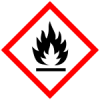Toxicty
GHS safety labels
- H225

Highly flammable liquid and vapour
Class: Flammable
Subclass: Liquids - H315

Causes skin irritation
Class: Corrosion/irritation
Subclass: Skin - H319

Causes serious eye irritation
Class: (Corrosion)Damage/irritation
Subclass: Eye - H335

May cause respiratory irritation
Class: STOT-respiratory irritation
Subclass: Single exposure - H336

May cause drowsiness or dizziness
Class: STOT-CNS
Subclass: Single exposure - H360
May damage fertility or the unborn child (state specific effect if known)(state route of exposure if it is conclusively proven that no other routes of exposure cause the hazard)
Class: Toxic to Reproduction - H373

May cause damage to organs (state all organs affected, if known) through prolonged or repeated exposure (state route of exposure if it is conclusively proven that no other routes of exposure cause the hazard)
Class: STOT
Subclass: Repeated exposure
